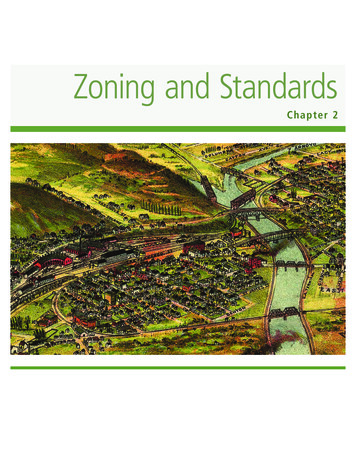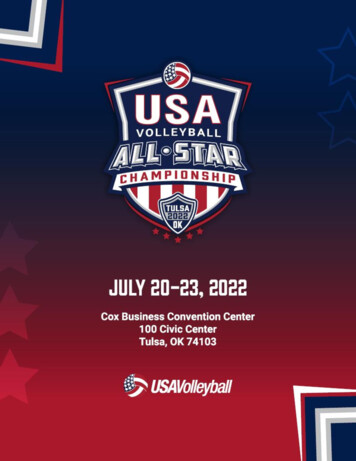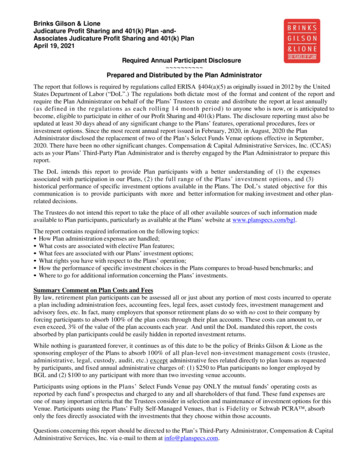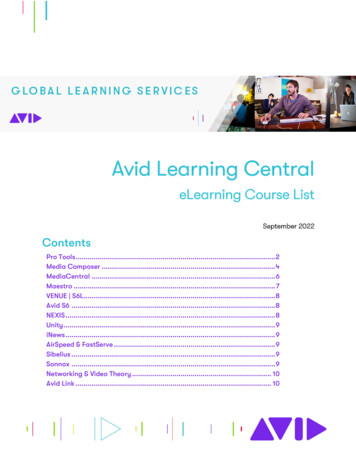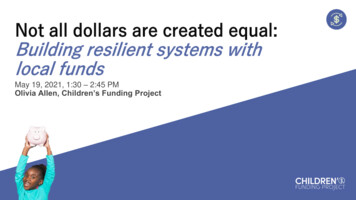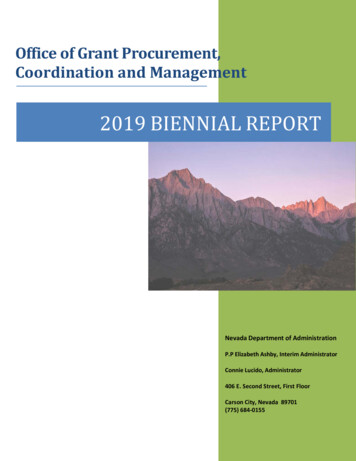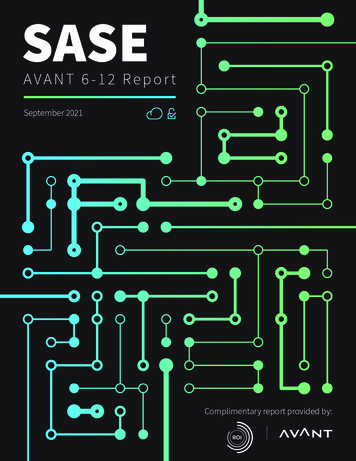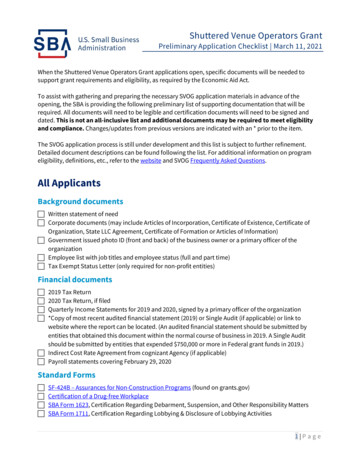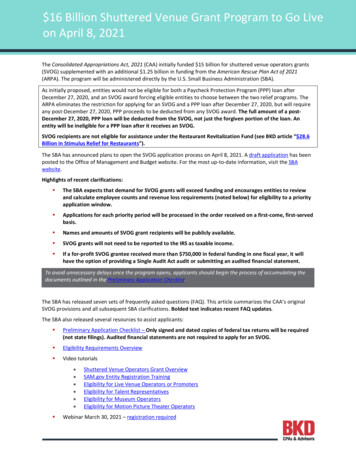
Transcription
16 Billion Shuttered Venue Grant Program to Go Liveon April 8, 2021The Consolidated Appropriations Act, 2021 (CAA) initially funded 15 billion for shuttered venue operators grants(SVOG) supplemented with an additional 1.25 billion in funding from the American Rescue Plan Act of 2021(ARPA). The program will be administered directly by the U.S. Small Business Administration (SBA).As initially proposed, entities would not be eligible for both a Paycheck Protection Program (PPP) loan afterDecember 27, 2020, and an SVOG award forcing eligible entities to choose between the two relief programs. TheARPA eliminates the restriction for applying for an SVOG and a PPP loan after December 27, 2020, but will requireany post-December 27, 2020, PPP proceeds to be deducted from any SVOG award. The full amount of a postDecember 27, 2020, PPP loan will be deducted from the SVOG, not just the forgiven portion of the loan. Anentity will be ineligible for a PPP loan after it receives an SVOG.SVOG recipients are not eligible for assistance under the Restaurant Revitalization Fund (see BKD article “ 28.6Billion in Stimulus Relief for Restaurants”).The SBA has announced plans to open the SVOG application process on April 8, 2021. A draft application has beenposted to the Office of Management and Budget website. For the most up-to-date information, visit the SBAwebsite.Highlights of recent clarifications: The SBA expects that demand for SVOG grants will exceed funding and encourages entities to reviewand calculate employee counts and revenue loss requirements (noted below) for eligibility to a priorityapplication window. Applications for each priority period will be processed in the order received on a first-come, first-servedbasis. Names and amounts of SVOG grant recipients will be publicly available. SVOG grants will not need to be reported to the IRS as taxable income. If a for-profit SVOG grantee received more than 750,000 in federal funding in one fiscal year, it willhave the option of providing a Single Audit Act audit or submitting an audited financial statement.To avoid unnecessary delays once the program opens, applicants should begin the process of accumulating thedocuments outlined in the Preliminary Application Checklist.The SBA has released seven sets of frequently asked questions (FAQ). This article summarizes the CAA’s originalSVOG provisions and all subsequent SBA clarifications. Bolded text indicates recent FAQ updates.The SBA also released several resources to assist applicants: Preliminary Application Checklist – Only signed and dated copies of federal tax returns will be required(not state filings). Audited financial statements are not required to apply for an SVOG. Eligibility Requirements Overview Video tutorials Shuttered Venue Operators Grant OverviewSAM.gov Entity Registration TrainingEligibility for Live Venue Operators or PromotersEligibility for Talent RepresentativesEligibility for Museum OperatorsEligibility for Motion Picture Theater OperatorsWebinar March 30, 2021 – registration required
16 Billion Shuttered Venue Grant Program to Go Live on April 8, 2021The SBA is building the application process in the System for Award Management (SAM.gov). To register in theSAM.gov system, a Data Universal Number System 1 (DUNS) number is required. Another prerequisite for SAMregistration is the creation of a login.gov account. As the SAM registration may take up to two weeks oncesubmitted, the SBA recommends that potential applicants start the process as soon as possible.The SBA will deny an SVOG application for any of the following reasons: Incomplete application submitted Fraud against the federal government Applicant fails to meet the definition of an eligible entity Applicant lacks the required revenue loss Applicant possesses one or more of the disqualifying conditions or is part of a group of affiliated entitiesthat currently has five active SVOG applications still pending SVOG funding is exhaustedIf an entity submits an honest, good faith SVOG application but is denied funding for failure to meet one or moreeligibility requirements, there would be no penalty and it would be free to apply for other programs it may qualifyfor. If, however, an entity makes material misrepresentations on its application as part of a fraudulent effort toobtain SVOG funding, it will have committed an act of perjury and be subject to various civil and criminal penalties,as well as potentially being debarred from doing business with the federal government.The SBA will not have an appeal process for denied SVOG applicants; the SBA expects that demand for SVOGgrants will exceed funding.I. COVID-19 Relief & SVOG EligibilityEntities that received a PPP loan before December 27, 2020, are eligible to apply for an SVOG. Under the ARPA, aneligible entity may apply for both the PPP and an SVOG; however, any PPP loan proceeds after December 27, 2020,will reduce the amount of the SVOG award.Pandemic-related or other assistance from state or local governments does not disqualify an entity from the SVOGprogram; however, an entity cannot claim any costs or expenses under its SVOG that it has already receivedreimbursement or other payment for under another award or program.II. General EligibilityEligible Person or EntityLive venue operators or promoters, theatrical producers or live performing arts 2 organization operators, motionpicture theater operators, museum operators, or talent representatives must have been in operation on February29, 2020, and had a 25 percent or greater drop in gross earned revenue during any quarter of 2020 as comparedto the same quarter of 2019. An entity is any of the 50 states as well as the District of Columbia, Puerto Rico, andany other territory or possession of the United States (Guam, American Samoa, U.S. Virgin Islands) and is eligibleto apply for an SVOG.If an organization does not have a DUNS number, or no one knows it, visit the Dun & Bradstreet (D&B) website orcall 1.866.705.5711 to register or search for a DUNS number. A DUNS number is a unique nine-character numberused to identify an organization. The federal government uses the DUNS number to track how federal money isallocated.2Events such as musical concerts, comedy shows, theatrical productions, dance performances, or other liverenderings of similarly artistic works.12
16 Billion Shuttered Venue Grant Program to Go Live on April 8, 2021An entity not in business in 2019 but conducting business operations as of February 29, 2020, may be eligible if itcan show the required earned revenue loss. Firms not in operation in 2019 may qualify for an SVOG if their grossearned revenues for the second, third, or fourth quarter of 2020 demonstrate a reduction of not less than 25percent from their gross earned revenues for the first quarter of 2020. Conducting business operations includesincurring costs of necessary startup and preparatory activities in the lead time before an anticipated opening date.Firms that had commenced startup operations but were unable to open as anticipated due to the pandemic wouldonly be eligible if they had earned revenue in the first quarter of 2020 from sources such as advance ticket sales,merchandising, etc.Firms that had been conducting business operations and incurring expenses in 2020 in a pre-opening capacity buthad no earned revenue for the first quarter of 2020 would not be eligible to apply.All types of entities are eligible for this relief, including for-profit, not-for-profit (NFP), government-owned,corporations, limited liability companies, partnerships, and sole proprietorships. The CAA does not preclude reliefeligibility for entities owned by a state or a political subdivision of a state; however, the relief is only availablesolely to venue operators and not any other entities of a state or political subdivision that are not venue operators.For example, a city parks and recreation department that operated a bandstand in a public square along withrunning various nature parks would not qualify as an eligible entity for an SVOG.The following items preclude an otherwise eligible firm from an SVOG: It does not have a place of business located in the U.S., does not operate primarily within the U.S., anddoes not make a significant contribution to the U.S. economy through payment of taxes or use ofAmerican products, materials, or labor. It was not in operation as of February 29, 2020. It applied for and/or received a PPP loan on or after December 27, 2020. It is a publicly traded corporation or is majority owned and controlled by a publicly traded corporation.The SBA defines majority ownership and control to mean that at least 51 percent of the ownershipinterests in an entity (regardless of its legal structure) are held by a single individual or entity. This is theonly control requirement. A live venue operator with a minority investor (less than 51 percentownership) that has more than 500 employees, locations in 11 or more states, and locations in two ormore countries would be SVOG eligible. It presents live performances or sells products or services of a prurient sexual nature. More than 10 percent of its 2019 gross revenue came from the federal government (not counting disasterassistance). See below for additional insight on this limitation. It owns or operates venues, theaters, museums, or talent agencies in more than one country; owns oroperates venues, theaters, museums, or talent agencies in more than 10 states; and had more than 500employees as of February 29, 2020. Five other firms with which it is affiliated have already received SVOG awards. It is a museum and other museums with which it is affiliated have already received 10 million in SVOGfunding.BankruptcyEligible entities undergoing a reorganization form of bankruptcy (such as Chapter 11 or Chapter 13) may apply foran SVOG if they entered bankruptcy after February 29, 2020. Entities undergoing a liquidation form of bankruptcy(such as Chapter 7) are not eligible. SVOGs made to entities undergoing reorganization bankruptcy may, in SBA’sdiscretion, be subject to special restrictions or requirements designed to reduce the risk of loss of taxpayer funds.3
16 Billion Shuttered Venue Grant Program to Go Live on April 8, 202110 Percent Cap on Federal FundingThis criterion was a significant focus of a number of FAQs. Entities owned by state or local governments are not subject to the 10 percent cap. The CAA establishesan alternate eligibility restriction for state-owned entities. Under that restriction, state-owned entitiescannot contain any other state-owned entities apart from the live venue operator or promoter, liveperforming arts organization operator, museum operator, movie theater operator, or talentrepresentative. Public university-based eligible entities are not subject to the 10 percent cap on the federal share of theirgross revenue. If a private university-based entity lacks separate legal existence from its parent university,or has separate legal existence but is majority owned and controlled by the university, it will have to lookto the parent university’s gross revenue when determining whether it passes this 10 percent threshold. Ifa private university owns less than a majority of an eligible entity with separate legal existence, the entityonly needs to consider whether 10 percent of its own 2019 gross income came from federal funding. Pell grants would be included in the amount of federal funding provided to college- and university-ownedentities that do not have separate legal existence.Ownership Transfers & Legal Status ChangesThe SBA will consider the new owner of an eligible entity to have stepped into the shoes of the prior owner, andwill permit the new owner to use the prior owner’s revenues as its own if the transferred entity was operational asof February 29, 2020, regardless of the date of the sale.A person or entity must have been an eligible entity as of February 29, 2020, to qualify for an SVOG.The FAQ provides the following examples:A movie theater operator with multiple theaters operating under the same employer identification number (EIN)as of February 29, 2020, subsequently receives separate EINs for each theater after February 29, 2020. Thoseentities would not be SVOG eligible because these movie theaters were not eligible entities on their own on orbefore February 29, 2020. Legal status changes after that deadline cannot be treated the same as ownershipchanges of eligible entities made after February 29, 2020.A new theater owner/operator previously owned/operated by a non-SVOG eligible company, e.g., a companylisted on a stock exchange. The new owner is eligible for an SVOG assuming the sale of the theaters to the newowner/operator was executed on or before February 29, 2020. Sales finalized after February 29, 2020, would notqualify because the underlying theaters were not eligible entities as of the deadline.SubsidiariesFor SVOG grant purposes, a subsidiary business is defined as an entity that is either wholly or majority owned andcontrolled by another entity. For entities with multiple subsidiaries, the parent entity must meet the eligibilitycriteria, but each subsidiary does not need to meet the criteria independently. However, if a subsidiary wants toapply for its own SVOG in its own name, it must meet the eligibility requirements. Each entity is looked atindependently if it is a separate legal entity under a parent organization and each location would need to meet itsindividual requirements to be eligible to apply. Subsidiary entities that qualify for an SVOG will not be treated asaffiliates of their parent entity or one another.A consolidated tax return does not strip subsidiary or affiliated entities of any separate legal existence they maypossess. If both legal entities have their own separate legal existence and each meets the eligibility criteria,either could apply for an SVOG.4
16 Billion Shuttered Venue Grant Program to Go Live on April 8, 2021If a parent company is ineligible for an SVOG, one or more of its subsidiaries can still be eligible (up to fiveparent/subsidiary entities) provided they can meet eligibility requirements in their own right; however, asubsidiary would not be eligible where it is majority owned and controlled by a parent entity that is either listed onthe stock market or operates eligible entities in more than one country and more than 10 states and has morethan 500 employees.A maximum of five business entities related via affiliation, i.e., one parent firm and four subsidiaries, can receive anSVOG. In addition, an eligible museum and all other museums it operates as subsidiaries may receive no more than 10 million combined under the program.Any applications received above the five affiliate limit will be rejected without being considered; however, if anapplication is evaluated and declined, another eligible affiliate could then apply.Shared Revenues & ExpensesSeparate legal entities that consolidate revenues and have never separately allocated between the consolidatedentities and meet all other eligibility requirements can apply a reasonable method of dividing the revenuebetween entities to apply for separate SVOGs. Entities should consider the roles and responsibilities of each entityand the effort and other resources each contributed to the consolidated operations and ensure that any allocationis reasonable and well documented.If a parent entity shares costs with its subsidiaries, the parent’s shared costs (or allocated costs to subsidiaries)remain as such, and the parent should keep records to show that all expenses claimed under the grant servedgrant purposes. If a subsidiary is eligible to apply for and applies for its own grant, only the portion of the sharedcost that the subsidiary pays can be paid for by the SVOG should it be received.Affiliation Rules & Common OwnershipSVOG is not strictly a small business program; the SBA is administering the program by statute. Consistent with thesize regulations for disaster financial assistance programs, the SBA will only consider two firms to be affiliatedfor purposes of the SVOG program where one firm owns more than 50 percent of the other or a single person orentity owns more than 50 percent of both. While affiliates may apply for the SVOG program in their own nameassuming they meet the eligibility requirements or may be included in an application submitted by theirultimate parent entity, they cannot team up together on an application unless one of the firms owns more than50 percent of the other.For example, if Company A owns 100 percent of Company B, which owns 100 percent of Company C, thenCompany C could apply in its own name or be included in either A or B’s application. Conversely, if CompaniesB and C are both 100 percent owned by Company A, then they could each apply in their own name or beincluded in A’s application, but B and C could not pair up together to submit an SVOG application.The SBA will only consider affiliation in two ways for the SVOG program: The CAA’s specific affiliation requirements: Affiliated firms (including subsidiaries) may apply for an SVOG on their own if they meet all theeligibility requirementsNo more than five affiliated firms may receive SVOGs. Each affiliate should apply using its ownSAM registration. This rule does not apply for entities owned by state or local governmentsSmall employer set-aside. This is the only definitive size limit and the SBA will administer this in the sameway it does other size limits (will look to the total number of full-time employees retained by theapplicant and all its affiliated entities)Only one SVOG application and award will be allowed per EIN. If a parent entity’s EIN is used, the parent mustmeet the statutory definition of an eligible entity rather than its subsidiaries or internal divisions. If an entity is5
16 Billion Shuttered Venue Grant Program to Go Live on April 8, 2021applying under one EIN for multiple theater locations, the application documentation requirements should beprovided for each location.Affiliation issues can be complex; the SBA has a general guide to business affiliation principles.A parent company can submit an application that includes some or all of its subsidiaries. The member firms of agroup of subsidiaries or affiliates are not obligated to all make the same choice of a PPP loan or an SVOG.III. Revenue CalculationGross revenue is defined by the SBA as being equivalent to receipts, “all revenue in whatever form received oraccrued from whatever source.” This would include contributions, donations, and grants from all sources. SVOGeligibility (the 25 percent reduction in gross earned revenue qualification) is based on a smaller subset of grossrevenue, which the SBA refers to as gross earned revenue. Only monies organizations receive from the sale ofgoods or services are counted as earned revenue. Earned revenue does not include donations, sponsorships,governmental assistance, or investment returns. Gross earned revenue is the total of earned revenue from varioussales of goods or services, such as admission tickets, merchandise, food and beverages, advertising sales, andcontracted presentation income. School tuition would be treated as earned revenue, e.g., a dance school thatoperates as part of a live venue. Gross earned revenue would include rental income from longer-term tenants andfrom short-term rentals for event hosting because they derive from standard commercial transactions for the paiduse of facilities. The SBA defines earned revenue and gross earned revenue in accordance with common principlesof the accrual method of accounting.The SBA will categorize a partner’s standard, nonpassive revenue (reported on IRS Schedule K-1) as both grossrevenue and earned revenue. If an entity is refunding all its revenue due to COVID-19 closures, it may includerefunded amounts in both gross revenue and earned revenue.Any grants or other funding received from the Coronavirus Aid, Relief, and Economic Security Act (CARES Act) aredisregarded in determining the reduction in gross earned revenue. Disaster assistance funds from a stategovernment also are excluded from an entity’s gross revenues.If an entity has multiple lines of business activity, it should use its gross earned revenue across all its lines ofbusiness activities and not exclude non-SVOG revenue streams.Gross earned revenue does not include donations and other gratuitous contributions such as foundation grantsand individual gifts. For fundraising event receipts, the portion of the amount an individual pays in connection witha fundraising event that represents the estimated value of the good or service they receive in exchange must beincluded in gross earned revenue; the portion of the amount such an individual pays that exceeds the estimatedvalue of the good or service they receive will be considered a donation and is not included in gross earnedrevenue.Taxes collected for and remitted to a taxing authority, returns, and post-sale discounts may be deducted fromearned revenues.Corporate sponsorship treatment will depend on whether an entity is an NFP. Sponsorship payments (such asnaming rights) received by for-profit entities will be considered earned revenue. For NFPs, sponsorship paymentsreceived will be considered part earned revenue and part gross revenue, similar to the treatment of membershipsand fundraising noted below. The sponsorship payment amount an NFP receives that represents a fair marketvalue for services in exchange, i.e., promotion, free admission, or use of facilities, will be deemed earned revenueand the portion of the sponsorship payment that exceeds that amount will be deemed a contribution and thusgross revenue.6
16 Billion Shuttered Venue Grant Program to Go Live on April 8, 2021Capital funds, restricted grants, or investment income will be considered for determining an entity’s grossrevenue in determining qualification for a priority window and determining whether an applicant meets therequirement that no more than 10 percent of its 2019 gross revenue came from the federal government,excluding disaster assistance.NFP ConsiderationsBoth contributions and grants are excluded from an organization’s earned revenue. However, the SBA will consideran organization’s federal grants revenue to determine whether it meets the eligibility limit of having no more than10 percent of its gross earned revenue from federal sources, not including disaster assistance. For membershiprevenue, the portion of membership cost that represents the estimated value of the goods or services provided asa condition of membership should be included in gross earned revenue. The portion of a membership cost thatexceeds the estimated value of the goods or services provided as a condition of membership is considered acontribution and excluded from gross earned revenue.If an entity is a hybrid NFP/governmental entity, it should apply under the NFP’s name and submit documentationdemonstrating the public/private partnership aspects.If a ticket to a fundraising dinner costs 100 per person and the estimated value of the dinner provided is 50, then 50 of the funds generated from the fundraising ticket would be considered gross earned revenue and the other 50 would be considered a donation and would be excluded from gross earned revenue.FoundationsAn NFP foundation that exists solely to receive donations for a museum or live venue operator is not eligible for anSVOG even if it has no economic or business activity apart from receiving and passing along donations. Thefoundation’s principal business activity would be serving as a fiscal agent rather than acting as a museum operatoror live venue operator or promoter as is required by the CAA.Single AuditsA nonprofit or governmental organization with federal expenditures in excess of 750,000 is required by law tohave a Single Audit performed, which includes an audit of both the financial statements and the federal awards.The Single Audit reviews how the grant was managed and ensures any applicable rules were followed. All SVOGgrants will count toward an entity’s 750,000 threshold for compliance with the Single Audit Act.With the influx of federal funding related to the CARES Act and other COVID-19 legislation, many entities willundergo their first Single Audit this year. If you are not sure if your organization is subject to the Single Auditrequirements, or if you want more information, contact your BKD Trusted Advisor .IV. Operator/ Promoter/Talent Representative CriteriaLive Venue Operator/Promoter CriteriaAs of the grant date, the venue is opened or intends to reopen, and one of two following criteria must be met: The individual’s or entity’s principal business activity must be to organize, promote, produce, manage, orhost live concerts, comedy shows, theatrical productions, or other events by performing artists for which: A cover charge through ticketing or a front door entrance fee is applied, and performers are paidin an amount that is based on a percentage of sales, a guarantee (in writing or standardcontract), or another mutually beneficial formal agreement. The use of volunteers in theproduction cast would not disqualify an entity, if the NFP performances are produced andmanaged primarily by paid employees7
16 Billion Shuttered Venue Grant Program to Go Live on April 8, 2021 Not less than 70 percent of the earned revenue is generated through cover charges or ticketsales, production fees or production reimbursements, nonprofit educational initiatives, or thesale of event beverages, food, or merchandise. The SBA defines “cover charges” to encompassfront door entrance fees, food or beverage minimums, or other similar charges required to gainadmission to a venue, whether collected via ticket sales, addition to a tab, or direct paymentAn individual or entity that, as a principal business activity, makes available for purchase by the public anaverage of not less than 60 days before the date of the event tickets to live concerts, comedy shows,theatrical productions, or other events by performing artists—events for which performers are paid in anamount that is based on a percentage of sales, a guarantee (in writing or standard contract), or anothermutually beneficial formal agreementPrincipal Business ActivityTo determine a given firm’s principal business activity, the SBA will consider the distribution of an entity’s receipts,employees, and costs of doing business among the different lines of business activity in which its businessoperations occurred for the most recently completed fiscal year. An entity's principal business activity will be theone in which it has the greatest combined amount of revenues, expenses, employees and work hours, assets,contracts, and other business activity as compared to all its other lines of business. For example, although anagricultural fair or entertainment cruise may include live performing arts events, its principal business activity issomething other than serving as one of the eligible entity types in the statute. Where an eligible entity hasmultiple lines of business that are essentially tied regarding their share of the entity's overall business activity,they will all be deemed its principal business activities.The SBA also may consider other factors, such as the distribution of patents, contract awards, and assets, asappropriate.SVOGs are not available for service providers that support eligible entities, i.e., companies that provide stages,lighting, sound, cast, and other support for live performing arts or which showcase performers or pre-packagedproductions to potential buyers.A live venue operator, promoter, theatrical producer, live performing arts organization, or talent representativemust use qualifying venues (noted below) for the majority of the events it stages or books clients into, andnonqualifying venues also may be used.Talent Representative CriteriaA talent representative is an agent or manager for whom no less than 70 percent of their business operations (asmeasured with reference to their overall revenues, costs, devotion of time, contracts, and other indicia ofbusiness activity) involves the representation or management of two or more artists or entertainers. Theseoperations must involve booking or representing musicians, comedians, actors, or similar performing artistsprimarily at live events staged in venues or at festivals in exchange for compensation founded on the number oftickets sold or a similar basis.A talent representative must provide a list of performing artists they booked or managed in 2019 that includesthe venues for which they were contracted to perform, the city and state of the venues, and the performancedates. They also must submit a current roster of performing artists which they book or manage that primarilywork in live venues or festivals. This roster also must appear on the applicant’s website and be published inprint or online in an industry-recognized trade publication registry. A talent representative applicant mustprovide fully executed contractual service agreements between the talent representative and two artists, orsigned statements from two artists certifying the applicant represented them for live performances in 2019 and2020. A talent representative also must provide fully executed contracts for live performances that took place ina venue or at a festival in 2019 and 2020 for two artists the applicant managed or booked.8
16 Billion Shuttered Venue Grant Program to Go Live on April 8, 2021V. Specific Venue CriteriaVenue criteria for live event operators or promoters, theatrical producers, and live performing art organizationsmust have the following characteristics: A defined performance and audience space. A defined performance space is the distinct physical spacereserved solely for the presentation of a performance, such as drama, music, dan
Apr 8, 2021
